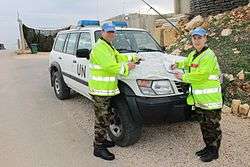Military Police Corps (Ireland)
| Irish Army Military Police Corps | |
|---|---|
| Irish: Cór Póiliní an Airm | |
 | |
| Active | 1 October 1924 – present |
| Country |
|
| Branch | Army |
| Type | Military police |
| Role | Enforcement of military law |
| Size |
4 companies 1st Brigade Military Police Company - Cork 2nd Brigade Military Police Company - Dublin Defence Forces Training Centre Military Police Company - Kildare Military Police Government Buildings Company - DFHQ/Dublin |
| Part of |
|
| Insignia | |
| Military Police Beret |
 |
The Military Police Corps (MP) (Irish: Cór Póiliní an Airm, PA)[1] is the corps of the Irish Army, a branch of the Irish Defence Forces, responsible for the provision of policing service personnel and providing a military police presence to forces while on exercise and deployment. Its tasks increase during wartime to include traffic control organisation and POW and refugee control. The Military Police are distinguished from other units by their wearing of a red beret.
The Military Police enjoy a close working relationship with the Garda Síochána, the civil police force of Ireland, at both national and local levels with the Gardaí providing specialist training to the Military Police in criminal investigation.
Irish Military Police are armed with the Steyr AUG assault rifle and Heckler & Koch USP service pistol.
The Corps has three regular army companies, and one special purpose company:
- 1st Brigade Military Police Company
- 2nd Brigade Military Police Company
- Defence Forces Training Centre (DFTC) Military Police Company
- Military Police Government Buildings Company
The two brigade companies provide general policing support to each of the army's territorial brigades. The DFTC company provides similar support to the Defence Forces Training Centre.
The Air Corps and Naval Service now have Military Police Sections dressed in their own distinctive uniforms.
The Irish Army reduced to a two brigade structure in 2012, and the Military Police have also been reduced, based in the 1st Southern and 2nd Northern Brigades.
Units disbanded in the Defense Forces Re-organisation of 2012:
- 4th Brigade Military Police Company (2012)
- Military Police Section, Air Corps. Attached Irish Air Corps (2012)
- Military Police Section, Naval Service. Attached Irish Naval Service (2012)
- 31st Reserve Military Police Company (2012)
- 54th Reserve Military Police Company (2012)
- 62nd Reserve Military Police Company (2012)

.jpg)
